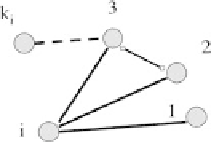Information Technology Reference
In-Depth Information
Another prescription for the determination of the parameter
C
was given by Watts
and Strogatz [
35
]. This prescription reads
i
=
1
C
i
C
=
N
,
(6.81)
where
N
denotes the number of nodes, the index
i
runs from 1 to
N
, and
C
i
is the local
clustering coefficient for the node
i
defined by
=
C
i
,
(6.82)
where
denotes the
number of triples connected with the i th node
. In the case of Figure
6.12
we see that
node 1
is the
number of triangles connected with the ith node
and
⇒
C
1
=
1, node 2
⇒
C
2
=
1, node 3
⇒
C
3
=
0, node 4
⇒
C
4
=
0 and node
5
⇒
C
5
=
1
/
6
.
Thus we obtain from (
6.81
)
+
+
/
1
1
1
6
13
30
.
=
=
C
(6.83)
5
An equivalent, but more intuitive, way of defining the clustering coefficient
C
i
is
illustrated in Figure
6.13
. We focus our attention on the
i
th node and consider all
k
i
nodes connected with it. If all the friends of the
i
th node are friends with one another,
the environment of the
i
th node has the number of connections
N
C
given by
k
i
(
k
i
−
)
1
N
C
=
.
(6.84)
2
Actually, for the
i
th node there will be a smaller number of connections,
i
. Thus, the
connectivity of the
i
th node is given by
2
i
C
i
=
)
.
(6.85)
k
i
(
k
i
−
1
=
(
−
)
In the case of a random web each node has
k
p
N
1
links. The approximate
number of links of its environment is given by
≈
k
(
k
−
1
)
p
i
(6.86)
2
and, consequently, in this case we find, assuming
C
=
C
i
,
k
1
≈
N
.
k
C
=
p
=
(6.87)
N
−
This graph illustrates an intuitive way of defining
C
i
. The full lines correspond to the realized
links. The dashed line corresponds to a generic set of nodes from node 4 to node
k
i
−
1
.
Figure 6.13.








